In summer 2018 Mars and Saturn are, one after the other, in opposition to Earth. Around the time of opposition, a planet is at its closest distance to Earth for a given year. Because of the close proximity, a planet also appears brightest in the sky. The NASA/ESA Hubble Space Telescope took advantage of this preferred configuration and imaged both Mars and Saturn to continue its observation of the outer planets in our Solar System.
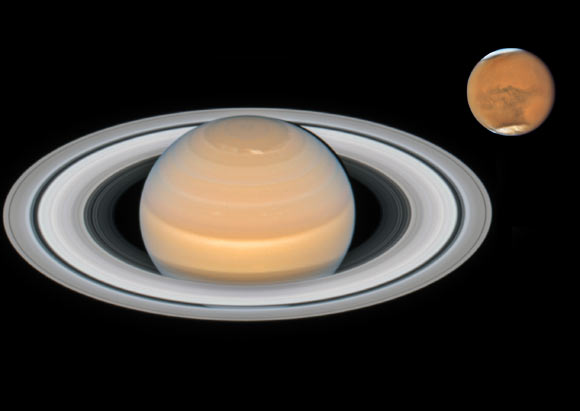
This image shows the recent observations of the planets Mars and Saturn made with Hubble. Image credit: NASA / ESA / A. Simon, NASA’s Goddard Space Flight Center / OPAL Team / J. DePasquale, STScI.
The new images from Hubble show that Earth isn’t the only planet where intense spring and summer storms wreak havoc.
“It’s now summertime in the northern hemisphere of Saturn and springtime in the Martian southern hemisphere,” Hubble astronomers said.
“The increase in sunlight in Saturn’s northern hemisphere has heated the atmosphere to trigger a large storm that is now disintegrating in the gas giant’s polar region.”
“On Mars, a dust storm erupted in the southern hemisphere and ballooned into a global dust storm enshrouding the entire planet.”
Hubble viewed Mars on July 18, when the planet was just 36.9 million miles (59.3 million km) from Earth, near its July 27 opposition. This close distance puts the Red Planet at its brightest appearance in the night sky since the 2003 opposition, when the planet made its way closer to us than at any other time in almost 60,000 years.
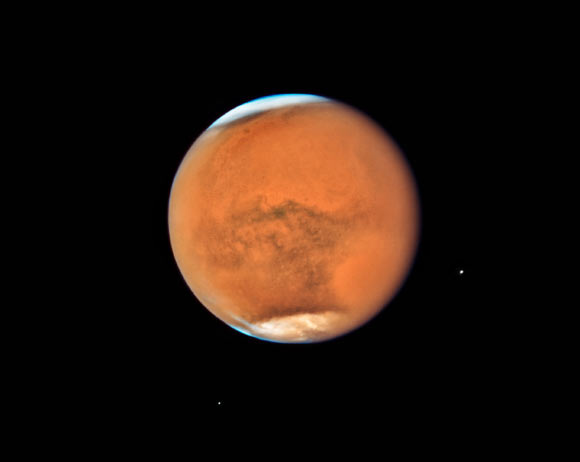
In mid-July Hubble observed Mars, only 13 days before the planet made its closest approach to Earth in 2018. While previous images showed detailed surface features of the planet, this new image is dominated by a gigantic sandstorm enshrouding the entire planet. Each Martian year, moderately large dust storms cover continent-sized areas and last for weeks at a time. Global dust storms tend to happen during the spring and summer in the southern hemisphere, when Mars is closest to the Sun and heating is at a maximum, leading to greater generation of winds. While spacecraft orbiting Mars can study the storm’s behaviour at lower altitudes, Hubble observations allow astronomers to study changes in the higher atmosphere. The combined observations will help planetary scientists to build a better understanding of how these global storms arise. Image credit: NASA / ESA / STScI.
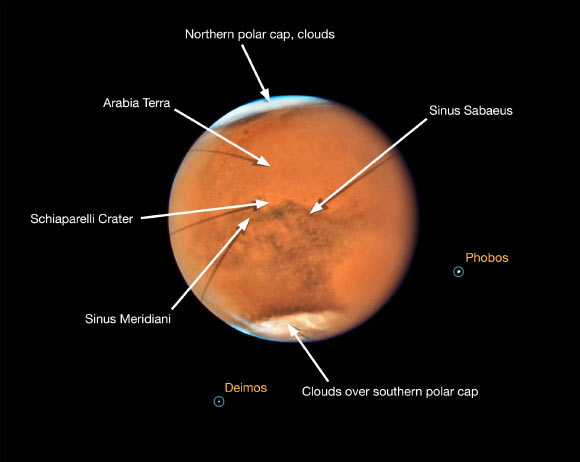
This annotated image of Mars shows features of the planet that were visible in summer 2018 despite a global dust storm. During the time of observation it was spring in Mars’ southern hemisphere, where a dust storm erupted and ballooned into a global event that is blanketing the entire planet. Even so, several distinctive features can be identified. The large oval area at the lower right is the bright Hellas Basin. About 1,367 miles (2,200 km) across and nearly 5 miles (8 km) deep, it was formed about four billion years ago by an asteroid impact. Many global dust storms originate in this region. The orange area in the upper center of the image is Arabia Terra, a vast upland region in northern Mars. The landscape is densely cratered and heavily eroded, indicating that it could be among the oldest terrains on the planet. South of Arabia Terra, running east to west along the equator, are the long dark features known as Sinus Sabaeus and Sinus Meridiani. These regions are covered by dark bedrock and fine-grained sand deposits ground down from ancient lava flows and other volcanic features. These sand grains are coarser and less reflective than the fine dust that gives the brighter regions of Mars their rusty appearance. Because it is autumn in the northern hemisphere, a bright blanket of clouds covers the north polar region. Clouds also can be seen over the southern polar cap. The two small moons of Mars, Phobos and Deimos, appear in the lower half of the image. Image credit: NASA / ESA / STScI.
“Mars has seasons, due in part to its 25-degree axial tilt, which is similar to Earth’s 23.5-degree tilt,” the researchers said.
“Unlike Earth, Mars’ more elliptical orbit has a greater influence on its seasonal changes. Its closest and most distant points from the Sun vary by 19% (as opposed to 3% for Earth).”
“Each Martian year, moderately large dust storms cover continent-sized areas and last for weeks at a time. Global dust storms — lasting for weeks or months — tend to happen during the spring and summer in the southern hemisphere, when Mars is closest to the Sun and heating is at a maximum to generate winds.”
Saturn was captured on June 6, at approximately 1.36 billion miles (2.2 billion km) from Earth, as it approached a June 27 opposition.
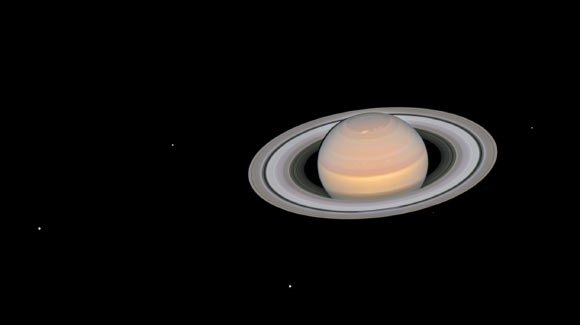
This composite image, taken by Hubble on June 6, 2018, shows the ringed planet Saturn with six of its 62 known moons. From left to right, the moons visible in this image are Dione, Enceladus, Tethys, Janus, Epimetheus, and Mimas. The moons seen here are all icy and cratered. Enceladus is considered a candidate for the existence of primitive life because it is outgassing water vapor from a subsurface ocean. Based on data from the Cassini mission to Saturn, scientists hypothesise that a small, wayward moon like one of these disintegrated 200 million years ago to form Saturn’s ring system. The image is a composite because the moons move during the Saturn exposures, and individual frames must be realigned to make a color portrait. Image credit: NASA / ESA / A. Simon, NASA’s Goddard Space Flight Center / OPAL Team / J. DePasquale, STScI.
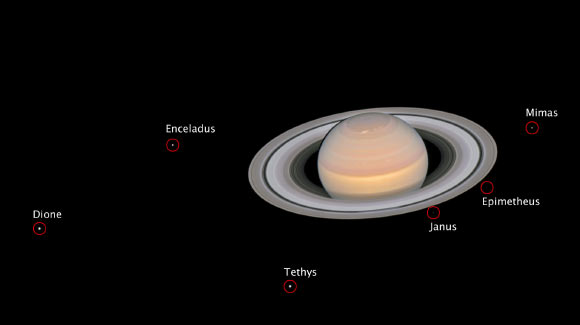
This annotated composite image, taken by Hubble on June 6, 2018, shows the ringed planet Saturn with six of its 62 known moons. With a diameter of 698 miles (1,123 km), Dione is the fourth-largest of Saturn’s moons and the largest of the siblings in this family portrait. The smallest satellite in this picture is the irregularly shaped Epimetheus, with a size of 89 x 67 x 61 miles (143 x 108 x 98 km). The image is a composite because the moons move during the Saturn exposures, and individual frames must be realigned to make a color portrait. Image credit: NASA / ESA / A. Simon, NASA’s Goddard Space Flight Center / OPAL Team / J. DePasquale, STScI.
“Saturn has seasonal changes caused by the planet’s 27-degree axial tilt,” the astronomers said.
“With summer in the northern hemisphere, the atmosphere is now more active. This may be responsible for a string of bright clouds visible near the northern polar region that are the remnants of a disintegrating storm. Small, mid-latitude puffs of clouds are also visible.”
“Hubble’s view also resolves a hexagonal pattern around Saturn’s north pole, a stable and persistent wind feature discovered during the Voyager flyby in 1981.”
“The planet’s magnificent ring system is also on full display and near its maximum tilt toward Earth, which was in 2017.”
Saturn’s portrait is the first image of the ringed planet taken as part of the Outer Planet Atmospheres Legacy (OPAL) project.
This project is helping planetary researchers understand the atmospheric dynamics and evolution of our Solar System’s gas giant planets.







